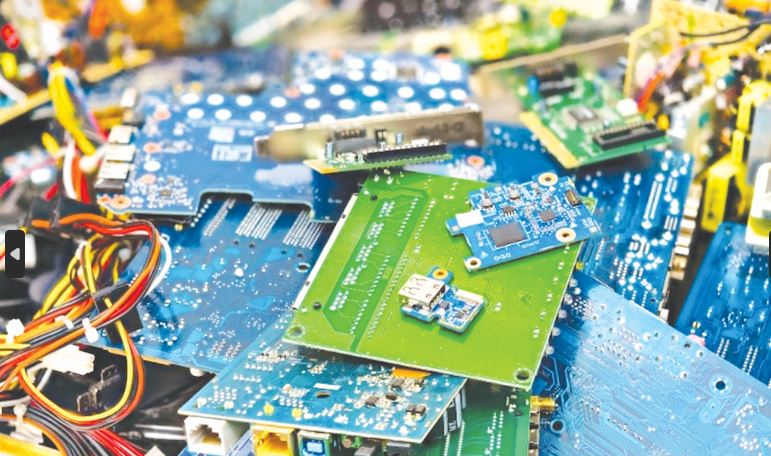Experts’ warn against disposing of electronics

Consumers worldwide have been urged to collect dead or unused electronics and electrical products and give them a second life by reusing, repairing or recycling them properly.
Above all, the public has been urged to stop tossing e-waste into household waste bins. The appeal was made as the world yesterday (Monday) marked the International E-Waste Day, whose theme was ‘Join the e-waste hunt – retrieve, recycle, and revive.’
The ‘Global E-Waste Monitor 2024’, authored by the United Nations Institute for
Training and Research (UNITAR) in cooperation with the International Telecommunications Union (ITU), reported almost a quarter of end-of-life electronic waste ends up in home trash.
Trashing this waste ends up squandering billions of dollars worth of copper, gold and other precious metals, materials critical to the production of such products, along with valuable plastics and glass.
The 14 million tonnes of e-waste (dead or unused products with a battery or plug) discarded with ordinary household waste works out to the weight of 24,000 of the world’s heaviest passenger aircraft.
This is enough to form an unbroken queue of giant planes from London to Helsinki, New York to Miami, Cairo to Tripoli, or Bangkok to Calcutta.
E-waste accumulation is reaching unsustainable levels and owing to management challenges, they are becoming a major source of environmental pollution. In Kenya, electronic waste is the fastest-growing waste component, with an estimated 51,300 tons of electronic waste generated annually.
Says Pascal Leroy, Director General of the Brussels-based Waste Electrical and
Electronic Equipment (WEEE) Forum: “Small electronic and electrical goods such as mobile phones, toys, remote controls, game consoles, headphones, lamps, screens and monitors, heating and cooling equipment, and chargers are everywhere.
Consumer products
“And electronic components embedded in consumer products large and small – even clothing – are now omnipresent. The 844 million e-cigarettes thrown away in 2022 alone contained enough lithium, for example, to power 15,000 electric cars.”
Adds Magdalena Charytanowicz of the WEEE Forum in charge of International E-Waste Day: “We know what to do, and we can do better.” She says the place to start is the junk drawer, a common feature of homes around the world.
Why do people hoard small WEEE?
Globally, there are 108 mobile phone subscriptions per 100 people. Earlier surveys have shown that European households alone store about 700 million unused or non-functioning mobile phones – an average of more than two per household.
Ms Charytanowicz adds that “hoarding is an issue predominantly in wealthier countries. Elsewhere, reasons for keeping appliances are often personal data concerns or a desire to recover some of their value.”
A recent survey helped explain why so many EU households and businesses fail to bring WEEE in for repair or recycling. The survey was undertaken by WEEE Forum members – not-for-profit entities that collect e-waste from households and businesses on behalf of manufacturers – and consolidated by UNITAR’s Sustainable Cycles (SCYCLE) Programme.
The 2022 survey showed the average European household contains 74 e-products, such as phones, tablets, laptops, electric tools, hair dryers, toasters and other appliances (excluding lamps).
Of the 74 average total e-products, 13 were being hoarded (9 of them unused but working, while 4 were broken).
Recycling e-waste
Complementary research reveals what motivates people to recycle e-waste: Knowledge – understanding where and how to dispose of e-waste and why our actions can make a difference.
Convenient collection points – making it easy for consumers to make the right gesture.
Compensation – some consumers are motivated by financial or other type of compensations. Social norms – following what others do.
Care for the environment – a growing concern for many.
Benefit charities – doing something good for others, such as offering unused appliances for reuse, is a great motivator.
People are often surprised by information about the positive CO2 impact of e-waste recycling or simply happy to have done the ‘right thing’.
Many Producer Responsibility Organisations (PROs) – members of the WEEE
Forum – organise communication campaigns and provide collection points, now more than 183,000 in all. To date, PROs have collected, cleaned, and recycled or sent for refurbishment 41.6 million tonnes of WEEE, (3.1 million tonnes in 2022).
Great progress is being made but everyone has a role to play as the volumes of e-waste generated grow rapidly, says Ms. Charytanowicz. Urging people to Join the E-Waste Hunt — Retrieve, Recycle and Revive — in 2024 the WEEE Forum outlined the Five Ws of e-waste recycling:
What: Any product with a battery or plug.
Where: WEEE Forum members’ collection points: weee-forum.org/members, or any other official e-waste collection point
Why: According to Global E-Waste Monitor 2024:
Global e-waste management reduces CO2 equivalent emissions by 93 billion kg
annually, equivalent to the annual emissions of more than 20 million cars. Proper e-waste recycling avoids leakages of harmful substance such as lead or cadmium to the environment
In 2022, e-waste produced globally contained approximately 4 billion kg of metals classified as critical raw materials, including 3.9 billion kg of aluminium, 34 million kg of cobalt, and 28 million kg of antimony. Recovering and reusing secondary raw materials from e-waste in 2022 avoided the need to mine 900 million tonnes of ore (the weight of 17,200 Titanics)
ITU Telecommunication Development Bureau Director Cosmas Luckyson Zavazava says: “Almost 80% of the world’s population today own a mobile phone. Among them, some have several devices, in some cases, each with its own type of chargers, cables and accessories.












